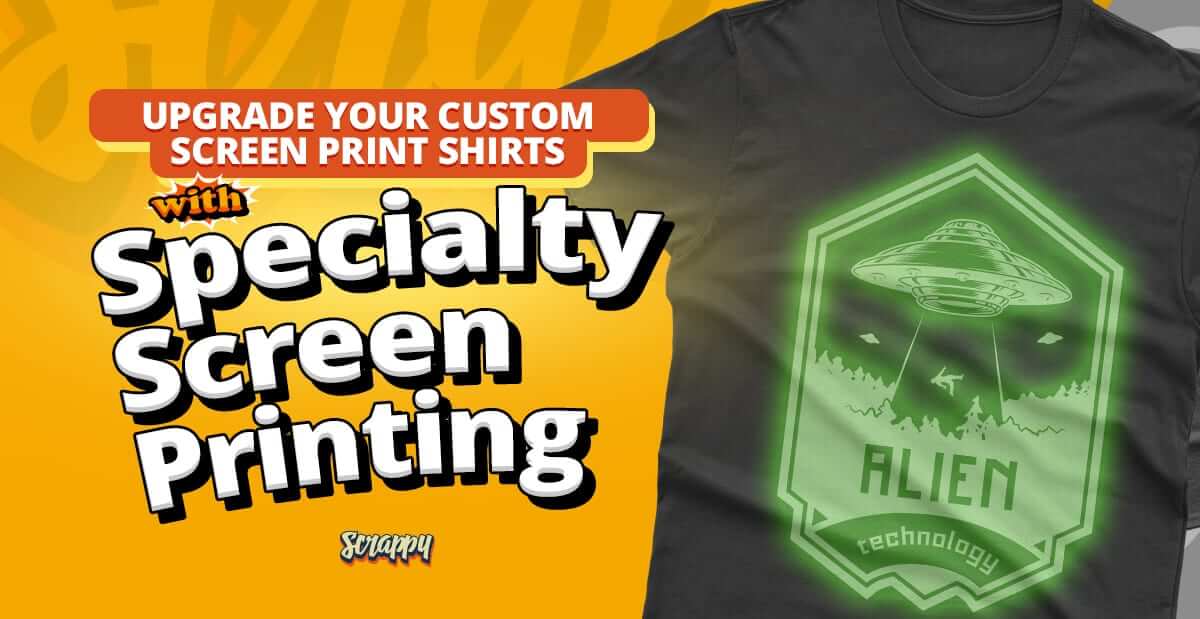High-Quality Custom Screen Printing for Team Apparel
High-Quality Custom Screen Printing for Team Apparel
Blog Article
Display Printing Uncovered: Everything You Need to Find Out About T-Shirt and Garment Printing Techniques
If you've ever before asked yourself exactly how those vibrant designs wind up on your favorite tees, you're in the right area. Display printing is an interesting technique that integrates art with technique, providing limitless opportunities for imagination. Recognizing the fundamentals, from devices to ink options, can substantially influence your outcomes. Prepared to discover the necessary aspects that make screen printing an art kind? Let's uncover the details that can elevate your projects.
The Basics of Display Printing: Exactly How It Functions
When you dive right into display printing, you'll find it's both a science and an art. At its core, screen printing includes creating a pattern, or display, that allows ink to pass with just in details areas.
Following, you'll blend your inks and prepare your printing surface area. Placement the screen over the textile, after that make use of a squeegee to press ink with the display onto the garment. This procedure needs accuracy, as you want clear, dynamic prints. After printing, you'll heal the ink with warmth, guaranteeing it abides by the fabric and lasts with cleans. Each action is crucial, and understanding them will raise your screen printing abilities, transforming basic garments into unique, expressive items.
Sorts Of Screen Printing Strategies
When you grasp the essentials of display printing, it's time to check out the various techniques that can boost your designs. One popular method is standard display printing, where ink is pushed with a stenciled screen.
One more choice is plastisol printing, known for its toughness and vibrant shades, making it a preferred for lots of brands. Experiment with halftone printing to develop gradient results and detailed layouts.
Crucial Devices for Display Printing
To accomplish spectacular outcomes in display printing, having the right equipment is basic. You'll require a sturdy display printing frame, which holds the mesh that moves your layout onto the garment. Next, spend in premium mops; these are essential for applying ink equally across the display.
Selecting the Right Inks and Products
When picking inks and materials for display printing, you need to take into consideration the kind of ink that works ideal for your job. Believe regarding textile compatibility to guarantee your styles look last and wonderful lengthy. Check out environment-friendly ink choices to make your printing procedure a lot more lasting.
Types of Display Inks
Choosing the best display ink is vital for attaining dynamic, long lasting prints that satisfy your project's demands. There are a number of sorts of screen inks to check out. Plastisol ink is prominent for its flexibility and simplicity of usage, providing superb color opacity on dark fabrics. Water-based ink, on the other hand, supplies a softer feel and is eco-friendly, making it perfect for those wanting to decrease their ecological effect. Discharge inks remove color from the textile, causing a soft, vintage look yet require certain handling. Specialized inks, such as glow-in-the-dark or metal, can include distinct effects to your layouts. Assess your project demands and choose the ink that aligns ideal with your preferred result.

Material Compatibility Considerations
Comprehending textile compatibility is essential for accomplishing top quality screen prints, particularly considering that various products react distinctively to numerous inks. When selecting inks, think about the textile kind-- cotton, polyester, or blends. For cotton, water-based inks work well, providing softness and breathability. Polyester, on the other hand, usually calls for plastisol inks for better attachment and vibrant shades. You might need to utilize a combination of both kinds if you're publishing on blends. Constantly check your inks on sample textile to ensure they stick effectively and maintain shade honesty. In addition, remember that material weight and texture can influence the final result, so selecting the appropriate ink and material combo is important for your task's success.
Eco-Friendly Ink Options
Eco-friendly inks are coming to be a preferred option for display printers that desire to decrease their environmental influence while keeping top quality. When picking inks, consider water-based inks, which are less damaging and less complicated to cleanse up compared to typical solvents.
Additionally, look for inks made from renewable resources, such as soy or vegetable-based alternatives. By selecting the right inks and materials, you'll not just develop stunning designs but additionally add to a much more sustainable printing process. Make the switch, and your prints will certainly mirror your commitment to the atmosphere!
Preparing Your Design for Screen Printing

File Layout Needs
To guarantee your style looks vibrant and sharp on material, you'll need to pay very close attention to submit layout requirements for display printing. Begin with vector documents like AI or EPS, as they can be scaled without shedding high quality. If you utilize raster images, select high-resolution files, such as TIFF or PNG, ideally at 300 DPI. Avoid utilizing JPEGs, as they can lose clearness when resized. Also, see to it your layout has a transparent history to avoid unwanted white edges on your prints. Finally, maintain color modes in mind; CMYK is basic for display printing, so transform your RGB develops accordingly. By complying with these guidelines, you'll set your artwork up for an effective print.
Shade Separation Strategies
Shade separation is a necessary step in preparing your design for screen printing, and grasping it can considerably boost your print high quality. You'll require to damage your layout into specific silk screen printing shades, as each color needs a separate screen during printing. Beginning by recognizing all the colors in your design and produce layers each. You can utilize software program like Adobe Photoshop or Illustrator to separate and different shades properly. Be particular to conserve each layer as a different data, typically in a style like TIFF or PSD. This precision not just guarantees precise color depiction but likewise simplifies the printing procedure. By taking note of shade splitting up, you'll attain professional and lively results in your screen-printed garments.
Resolution and Size
Achieving the most effective lead to display printing begins with assuring your layout has the appropriate resolution and size. Ideally, your artwork must be at the very least 300 DPI (dots per inch) for sharp, clear prints. If you use lower resolution, your last product could look pixelated and unprofessional.
When it comes to dimension, consider the dimensions of your print area. Layout your artwork to match the final print size, ideally developing it in the actual dimensions you'll be publishing. This way, you'll stay clear of any kind of unexpected scaling concerns.
Constantly examine your style in both vector and raster formats. Vector graphics can be scaled without shedding high quality, making them ideal for screen printing. Preparing appropriately will ensure your style looks outstanding on every garment!
Step-by-Step Screen Printing Refine
Display printing is a dynamic procedure that allows you to create lively layouts on different surfaces. To get begun, you'll need a screen, emulsion, and your selected ink.
Put ink onto the display and utilize a squeegee to push the ink with the pattern onto the textile. Lift the display thoroughly and allow the print dry. You have actually effectively screen printed your style.
Tips for Effective Screen Printing Projects
While you're diving into your display printing tasks, keep in mind that preparation is crucial to success. Begin by collecting all your products-- inks, garments, mops, and screens. A tidy work area aids stop unwanted mistakes, so clean up before you begin.
Next, confirm your art work is high-resolution and effectively sized for your garment. Check your display for correct direct exposure and clean it thoroughly to avoid smudges. When blending your inks, comply with the supplier's standards to attain the best consistency.
During printing, use also stress with your squeegee for consistent outcomes. Do not hurry; take your time to validate each print satisfies your requirements. After printing, let your garments completely dry totally prior to dealing with or packaging them.
Lastly, always keep an example of your help future referral. By doing this, you can assess your development and boost your strategies in time. Satisfied printing!
Often Asked Questions
How much time Does It Take to Establish up a Screen Printing Work?
Establishing up a display printing job normally takes around 30 minutes to an hour. You'll prepare the displays, mix inks, and adjust the press. The moment differs based on intricacy and experience, so stay organized!
Can I Print on Various Material Enters Utilizing the Exact Same Method?
Yes, you can publish on various fabric types making use of the exact same technique, yet you'll require to readjust your settings and inks. Some materials take in ink in a different way, so exploring warranties the very best outcomes for each material.
What Are Common Blunders to Stay Clear Of in Display Printing?
When screen printing, stay clear of common blunders like utilizing the incorrect ink, disregarding appropriate exposure times, or missing pre-press checks. Always test your configuration and preserve tidy displays to guarantee top quality results each time.
Exactly How Can I Effectively Tidy and Preserve My Display Printing Equipment?
To effectively tidy and preserve your screen printing equipment, you must consistently wash displays with suitable solvents, inspect squeegees for wear, and ensure all devices are kept dry and dust-free. Uniformity prevents costly repairs and boosts performance.
Is Screen Printing Eco-friendly Contrasted to Various Other Approaches?
Screen printing can be extra eco-friendly than other techniques, particularly if you make use of eco-conscious products and water-based inks. By picking lasting supplies and practices, you lower waste and decrease your effect on the planet.
Display Printing Uncovered: Whatever You Need to Know Regarding Tee Shirt and Garment Printing Strategies
At its core, screen printing entails producing a pattern, or screen, that enables ink to pass via only in certain areas. Position the screen over the textile, after that use a squeegee to press ink with the screen onto the garment. One prominent technique is conventional display printing, where ink is pushed with a stenciled screen.When picking inks and products for screen printing, you need to take into account the type of ink that functions best for your project.
Report this page